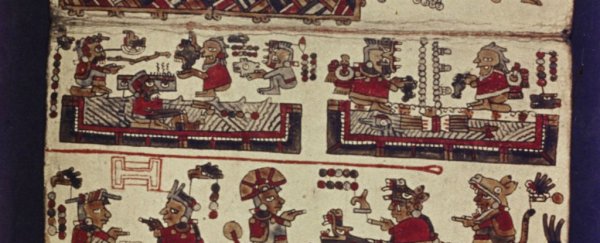Long before White-Out was invented, people still found ways to get a second chance at reusing a surface. Medieval scribes scraped the ink off sheets of animal hide to reuse the pages. Plenty of artists have painted over one image with another.
And now scientists have an example from the Americas as well, as reported in a new study in the Journal of Archaeological Science: Reports.
There are only a handful of manuscripts remaining from before Europeans came to the continent. They're made of leather strips coated with a white plaster-like substance called gesso.
The one the researchers studied is called the Codex Selden, and scholars have been suspicious for decades now that the book is hiding something beneath its surface.
But the Mixtec people who created the manuscript used inks made from plant materials. That means there haven't been any techniques that would give researchers the equivalent of X-ray vision, letting them see a hidden image without destroying the surface of the manuscript as we know it.
A fairly new technique called hyperspectral imaging changed that. It lets researchers take very high-resolution images at many different wavelengths of light. Those images can then be added and subtracted against each other to reveal the ghosts beneath a manuscript's surface.
The rare books community has been using it for the past couple years on a range of texts like the Archimedes Palimpsest, a lost manuscript of Archimedes hidden behind a 13th-century religious text, and the first map to feature the word "America" on it.
But this is the first pre-Columbian text to be scanned with hyperspectral imaging.
 Ludo Snijders et al.
Ludo Snijders et al.
What the scans revealed
The researchers haven't yet scanned all the pages, and note in the paper that interpretation can't really happen until the entire manuscript is scanned.
But they were still able to identify individual people in the original text. As they scan more, they may be able to connect those characters with historical figures.
While the text hasn't been translated, it's still exciting for a couple different reasons. Of course, when you have fewer than two dozen manuscripts from an entire region and period in history, any additions are exciting for scholars.
But from these early scans, the researchers were able to figure out that the hidden manuscript is a different style from any of the others that have survived. That means it could offer a new perspective on archaeological finds from the area.
The hidden text also flows sideways across page spreads, rather than from bottom to top the way the manuscript on the surface does.
Now that they have confirmed there's more to see under the surface, researchers are hoping the rest of the book can be scanned and even that these pages can be revisited with stronger light at different wavelengths to better understand the book and its history.
This article was originally published by Business Insider.
More from Business Insider:
